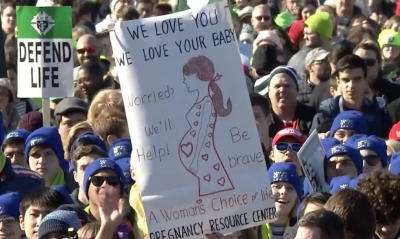Seeing major gains in pro-life sentiment

Last Thursday in The Federalist, Chris Humphrey continued our discussion about the factors behind the 50 percent decline in the U.S. abortion rate since 1980. Humphrey continues to argue that the increase in the number of pregnancy help centers provides the best explanation for the long-term decline in the U.S. abortion rate. He also argues there has not been a significant shift in public attitudes toward abortion.
However, I argue that a closer examination of public opinion data indicates there has been a shift in abortion attitudes, especially among young people. Furthermore, pro-life efforts to change hearts and minds will continue to be an important pro-life objective for a variety of reasons, including helping pregnancy help centers accomplish their lifesaving missions.
As I said in my previous Federalist article, public opinion on sanctity of life issues is nuanced and can be analyzed in different ways. That said, I want to emphasize a few points here.
First, the General Social Survey (GSS) provides the best long-term data on abortion attitudes. They have been asking the same six questions on abortion since the early 1970s. These questions include hard cases, such as whether abortion should be a legal option when the pregnancy results from a rape. They also include cases where more people would feel comfortable restricting abortion, such as where the woman is married and does not want additional children. The GSS collects a great deal of demographic data from respondents and is the dataset most frequently used by public opinion scholars.
Interestingly, for each of the six General Social Survey questions, public attitudes have shifted in a more pro-life direction since the mid ’90s. Humphrey downplays the shift in attitudes among young adults saying that “the change is very slight.” However, the fact that young adults ages 18 to 29 went from the age demographic most sympathetic to abortion in the ’70s to the age demographic least sympathetic in the aughts is certainly evidence of an important shift in public attitudes.
It is also a question that has engaged prominent public opinion researchers. Many are puzzled by this shift in abortion opinion among young people. The best predictors of pro-life sentiment are religiosity and conservative views on sexual issues. However, the current generation of young adults is not particularly religious and tends to have fairly liberal attitudes toward premarital sex.
Another important point is that abortion rates are not declining uniformly among various age demographics. In 2014, my Lozier Institute colleague Susan Willis analyzed the decline in the abortion rate between 1990 and 2010. During this time period, it fell by 35 percent. However, the age demographic that showed the largest-percentage decline were those aged 15-19, whose abortion rate fell by 71 percent.
Similarly, young adults aged 20-24 saw their abortion rate fall by 52 percent during that time period. Older demographics showed smaller declines in percentage terms. It is certainly likely that changing attitudes among young people might be playing a role in these large abortion rate declines.
The data Humphrey presents from Pittsburgh on the outreach efforts of Vision for Life is certainly interesting. However, more rigorous analysis of the impact of pregnancy help centers is needed. The Charlotte Lozier Institute, where I am an associate scholar, supports research that assists pregnancy help centers in their lifesaving mission.
I am working on an academic paper on the effect of pregnancy help centers on state abortion rates. I will be presenting this paper at the annual meeting of the Midwest Political Science Association this spring, and I look forward to sharing my results with both the pro-life and academic community.
Regardless of my findings, however, shifting public opinion in a pro-life direction will always remain an important policy objective for pro-lifers. If nothing else, gains in pro-life sentiment will improve the efficacy of pregnancy help centers and allow them to continue their vital, lifesaving work. States with a strong pro-life sentiment have been far less likely to enact burdensome regulations intended to hamper the work of pregnancy help centers.
Similarly, a woman facing an unintended pregnancy will be far more likely to seek out the services of a pregnancy help center if she and others around her are sympathetic to the pro-life message. Legislative, educational, and service efforts all continue to play a crucial role in building a culture of life in the United States.
Originally posted at thefederalist.com



























